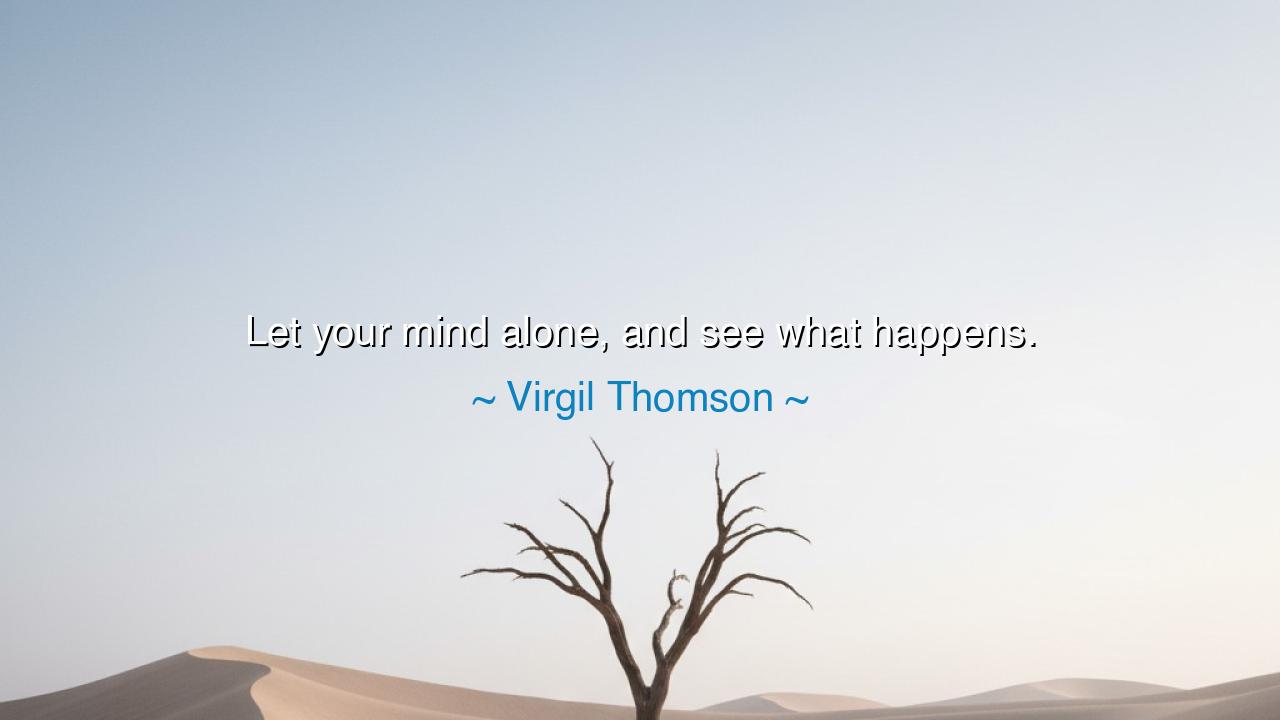
Let your mind alone, and see what happens.






"Let your mind alone, and see what happens." These words by Virgil Thomson evoke a profound truth about the nature of the mind and the power of stillness. In a world where we are constantly bombarded with information, demands, and distractions, the simple yet powerful suggestion to leave the mind alone invites us to step back and observe what arises when we cease our constant striving and effort to control every thought. Thomson’s words speak to the idea that the mind, when allowed to be still and free from interference, can find its own natural flow, clarity, and understanding. It is a call to trust the inherent wisdom that lies within, allowing the mind to unfold rather than trying to force it into shape.
In the ancient world, wisdom was often associated with the ability to quiet the mind. The Greek philosophers understood that true knowledge did not come through the constant accumulation of information, but through the practice of reflection and the cultivation of an inner state of peace. Socrates, for example, was not merely a teacher of facts, but a seeker of deeper truths, encouraging his disciples to question and reflect on their own thoughts and assumptions. He often spoke of the importance of self-examination—a process that requires the quieting of external noise and the focusing of one’s attention inward. It is through this stillness that the mind can reveal its deeper understanding, free from the distractions of daily life.
Consider also the teachings of Buddha, who emphasized the need for mental discipline and meditation as a way to achieve clarity and enlightenment. In his practice of Vipassana meditation, practitioners are instructed to observe their thoughts without judgment or interference, allowing them to rise and fall naturally. Through this practice, the mind becomes clearer, free from the noise and turbulence of desire and attachment. Buddha’s teachings echo Thomson’s words, suggesting that the true path to wisdom lies not in forcing the mind into rigid patterns, but in allowing it to rest, to observe, and to find its own natural state of peace.
This concept of letting the mind alone also resonates with the Stoic philosophers, such as Epictetus and Marcus Aurelius, who believed that the mind could only achieve tranquility when it was freed from the constant need for control over external events. For the Stoics, inner peace came not from shaping the world to our desires, but from accepting the world as it is and learning to detach from external expectations. By stepping back from the mind’s constant chatter and ceasing to interfere with its natural processes, we can cultivate a sense of calm and clarity that allows us to respond to life with wisdom and equanimity.
Thomson’s words also speak to the creative process, particularly in the realm of music and art, where he himself made significant contributions. The most profound artistic expressions often arise not from forceful efforts, but from a spontaneous flow of ideas and emotions. Consider the life of Leonardo da Vinci, who, despite his many distractions as an engineer, scientist, and painter, often spoke of the importance of stillness in his creative work. Da Vinci did not force his art to emerge; rather, he allowed it to come forth naturally, giving his mind the freedom to explore and discover without interruption. This act of creative surrender is a powerful demonstration of what happens when we “let the mind alone.”
The lesson we can draw from Thomson’s reflection is that true clarity and creativity come from allowing the mind to rest. In our fast-paced world, where we are often encouraged to constantly push forward, multitask, and control every aspect of our thoughts and actions, Thomson’s call to let the mind alone offers a refreshing reminder. It is in these moments of stillness, where we cease the constant effort to shape our thoughts, that we allow our true creative energy to emerge. The mind, when not overburdened with forced intentions or external pressure, can find its natural rhythm and lead us to deeper insights.
Practical action in response to Thomson’s wisdom is to create space for stillness in our daily lives. Whether through meditation, silent reflection, or simply allowing moments of quiet throughout the day, we must learn to step back and let our minds rest. In these moments, we may find that the clarity we seek arises without force, as if the answers were always there, waiting to emerge from within. Just as the ancient philosophers and artists recognized, we must allow our minds the freedom to unfold, to observe, and to find their own way without unnecessary interference.
In conclusion, Virgil Thomson’s wisdom reminds us of the great power of stillness. Just as the greatest thinkers and creators in history understood, the true path to clarity and creativity lies not in the constant effort to shape the mind, but in letting it alone. By creating space for reflection, we allow our thoughts to flow naturally, uncovering the deep insights and wisdom that lie within us. Let us, then, learn to step back, trust in the process, and embrace the stillness, knowing that in this quiet space, our greatest truths can emerge.






AAdministratorAdministrator
Welcome, honored guests. Please leave a comment, we will respond soon